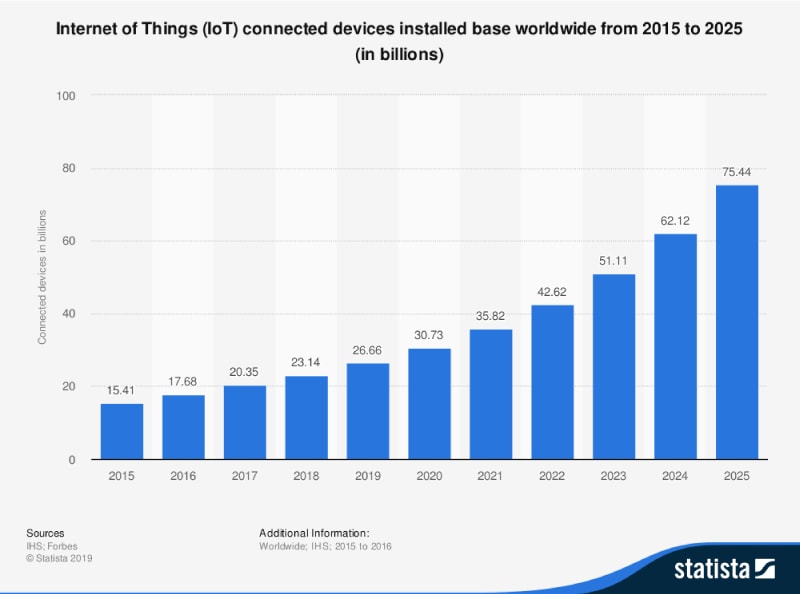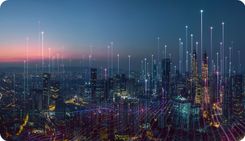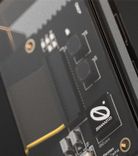What is The Internet of Things?


If you don’t live on a deserted island somewhere, à la Robinson Crusoe, chances are you have heard of the term “Internet of Things” (IoT). And you’ve probably read a handful of blog posts speaking about how the Internet of Things (IoT) is going to revolutionize trucking, fashion, healthcare and pretty much everything else. That’s all well and good but what exactly is the Internet of Things? What does this term really mean? If you’re like most of us, you probably know it’s got something to do with sensors, smart devices and wireless networks but could you explain what it means to a 5 year old? Being an IoT company, we thought we should end the confusion once and for all. So, here’s our simple, no-nonsense run-through on the Internet of Things.
We live in a world of smart devices. Today, it’s not just our phones that are smart- We now have “smart” versions of everything from toasters to lightbulbs. The Internet of Things is ushering us into a world of seamless connectivity where the boundaries between the digital and the physical world are practically non-existent.
What is IoT?
So, let’s start by defining the Internet of Things.
"Simply speaking, the Internet of Things is comprised of devices – from simple sensors to smartphones and wearables – connected together," says Matthew Evans, the IoT programme head at techUK.
A more standard, “technical” definition would be something along the lines of “the interconnection via the Internet of computing devices embedded in everyday objects, enabling them to send and receive data.”
“The Internet of Things is actually exactly what it sounds like - it means taking regular physical objects in the world and connecting them to the internet. It really is that simple.”
That’s just a very laboured way of saying something really simple - “The Internet of Things is actually exactly what it sounds like - it means taking regular physical objects in the world and connecting them to the internet. It really is that simple. Broadly speaking, these devices could be any object that is connected to the internet (but we generally don’t include traditional computing devices like smartphones or computers, when we use the term IoT). These devices collect and share data with one another, which can make them more intelligent and enable them to function more optimally.
Today, thanks to super-cheap chips and widespread wireless coverage, we are able to convert pretty much any “dumb” everyday object, be it a pill or even entire cities, into an IoT device. Adding sensors to these physical objects allows them to communicate on a real-time basis, without requiring any human intervention. This makes for a more responsive and connected world; They help us learn about and control our environments better. They help us harness the power of the network to run processes more smoothly and with lesser waste.
“The Internet of Things gives the opportunity for devices to communicate not only within close silos but across different networking types and so, helps create a much more connected world”
"It's about networks, it's about devices, and it's about data," explains Caroline Gorski, head of IoT, Digital Catapult. “The Internet of Things gives the opportunity for devices to communicate not only within close silos but across different networking types and so, helps create a much more connected world." These IoT devices could be anything - something small like a wireless temperature measurement device; or something as big as a driverless truck or an aircraft. The scope is endless for what an IoT device can be. Any everyday object that communicates with a network without human help, is an IoT device.
Why does IoT matter?
You are reading this on a device that is connected to the internet. Even if you are too young to personally remember a pre-internet world, you probably know how being connected to the internet makes your smartphone an exponentially more powerful piece of technology, than it’s “dumb” predecessors. A basic cellphone’s range of functionality (calling, texting etc) is dramatically expanded by connecting it to the internet. Now, in addition to calling and texting, you can literally read any book, listen to any song or research any given subject, right from the palm of your hand. So, it’s pretty intuitive to us that connecting something to the internet has some serious advantages.
When things have this ability to communicate, i.e transmit and receive information, it makes them smart and better at doing what they are designed to do. By harnessing the power of big data, every single device can shoot above its weight and be more efficient - This, in turn, makes the whole network operate more efficiently. Although in theory, this is true across the board, it is especially crucial within industrial applications. Deploying sensors on production lines can contribute to increased efficiency and clamp down on waste.
Types of IoT devices
An IoT device could perform one of the following functions:
1. It collects information and shares it
This includes sensors. Sensors can pick up information about temperature, motion, moisture, air quality, light, well you name it! Sensors allow us to understand environments better which helps us make better decisions.
For instance, modern jet-engines are chock full of sensors that collect and transmit data back to ensure that they are operating optimally. Here’s another example, closer to the ground - having access to information about soil moisture can enable farmers to know exactly when to water their plants. Moreover, they can use data to know just how much water their crops need, which is both economically and environmentally sensible.
In essence, sensors allow us to build more sophisticated models of our external environment. In turn, these data-rich models empower us to make better decisions in our everyday lives.
2. It receives information and acts on it
This may not seem very impressive on the face of it - I mean, isn’t that what a printer does? It receives information and acts on it, right? In principle, yes. But the applications and potential benefits are endless when you think about devices placed on extremely remote locations, where it’s not feasible to use manpower to perform operations.
3. It performs both these functions
IoT devices truly become game-changing tools when they can perform both these functions; i.e not only are they able to pick up vital information from the environment, but they are also then able to execute responses based on received information.
Let’s imagine the farming situation once again - what if the sensors, in addition to collecting data about the soil’s moisture content can also interface with the irrigation system, turning it on as needed, without actually requiring the farmer’s presence. Now that would translate to significant gains. In truth however, this is a very rudimentary example featuring a very basic setup. In practice, the sky's the limit for what can be learned by these systems, when a variety of sensors (light, air quality, temperature etc) are linked together. And here’s the cool part - when dozens or even hundreds of farms collect all this information, we can pool together this massive trove of data and use state-of-the-art algorithms to make even more rigorous predictions and identify patterns that could potentially have a significant impact on global food production.
History of IoT
In theory, the idea of incorporating sensors into basic objects is not all that new - it was discussed as far back as the 1980s. Kevin Ashton coined the term “Internet of Things”, all the way back in 1999! However, it would take the better part of a decade for the actual technology to match his prescient vision. The idea couldn’t really take off back then, save for a few early projects (like this internet-connected Coca-Cola vending machine). Progress was glacial simply because the technology wasn’t ready at that time. Chips were large and unwieldy and internet technology was too nascent.
This crazy idea of a world full of interconnected things could only be possible in a world with dirt-cheap, low-power processors that were all but disposable. The advent of RFID tags and the growing availability of high-speed mobile internet allowed the Internet of Things to find its footing. In the past, incorporating RFID tags was a very expensive proposition and was limited to expensive pieces of equipment. However, the cost of adding sensors and internet connectivity to things has continually plummeted, with some experts venturing that the cost might one day come down to a ridiculous 10 cents, making it possible to connect practically every single object to the internet!
Another important landmark in the history of IoT was the adoption of IPv6, which is the latest version of the Internet Protocol (IP) and provides devices on networks with unique identification and location systems. This was a crucial step that allowed the Internet of Things to scale. American tech-firm Cisco Systems estimates that it wasn’t until 2008-2009 that the IoT-proper was born. According to them, this was the time when the number of connected devices exceeded the number of people on the planet.
How big is the Internet of Things?
The Internet of Things is huge! And it’s growing. There are already more connected IoT devices than there are people. Despite falling well short of wild predictions from just a few years ago, the number of IoT devices worldwide has grown five fold in the last ten years. Current projections estimate 75.4 Billion connected IoT devices by 2025.

Challenges and concerns
It is a well-known fact that the Internet of Things is still in its infancy. One of the biggest challenges has been that IoT devices are often not able to connect to and communicate with each other. Security is another major concern. Data from IoT devices, just like any other data, is vulnerable to attack - For instance, in 2016, a Chinese IoT company had to recall 4.3 million units of their camera after a giant botnet attack that took several major websites and services offline.
Another massive challenge that faces the future of IoT is the battery problem. Essentially, it makes very little economic or ecological sense to power the rapidly growing number of IoT devices with batteries, no matter how energy-efficient they are. It makes no sense to deploy an IoT sensor in an extremely remote location only to have to transport personnel there to replace its battery. Plus, with the numbers that we’re dealing with, such a solution would just physically not be possible. However, newly emerging technologies like RF-energy harvesting promise a way around this battery bottleneck.
There are also concerns in some quarters about the potentially seedy implications of a hyper-connected world. There are fears that it might pave the way for unfettered surveillance and manipulation by governments and corporations. There have also been concerns about sensitive data falling into nefarious hands and being misused by parties interested in furthering their own agendas. Amidst these privacy concerns, it has been increasingly clear that IoT stakeholders need to make security a top priority.
What does all this mean to a consumer?
As a consumer, there is a lot to be excited about. The Internet of Things promises to make our living spaces more interactive and intelligent. As such, smart speakers like Amazon’s Echo or Google Home have become indispensable parts of modern homes across the globe. Smart devices offer us more convenience, security, and information.
It is entirely reasonable to imagine that in the near future, IoT devices will start to feature more and more prominently in our lives. Be it through smart homes reminiscent of Iron Man’s Jarvis or entire “smart-cities” teeming with sensors, the age of IoT is well and truly here. However, far from just pampering us with even more frivolous tech-thrills and hedonistic convenience, IoT holds promise in some very key areas. For example, IoT devices could help us study our natural environment in more depth and allow us to understand (and possibly, mitigate) pollution. Smart cities could change the way we interact with urban spaces. IoT devices could bring dramatic changes to the way we care for our health.
As mentioned earlier, the scope is nearly endless when it comes to IoT and the number of ways it is going to have a massive impact on our lives, in the near future.












